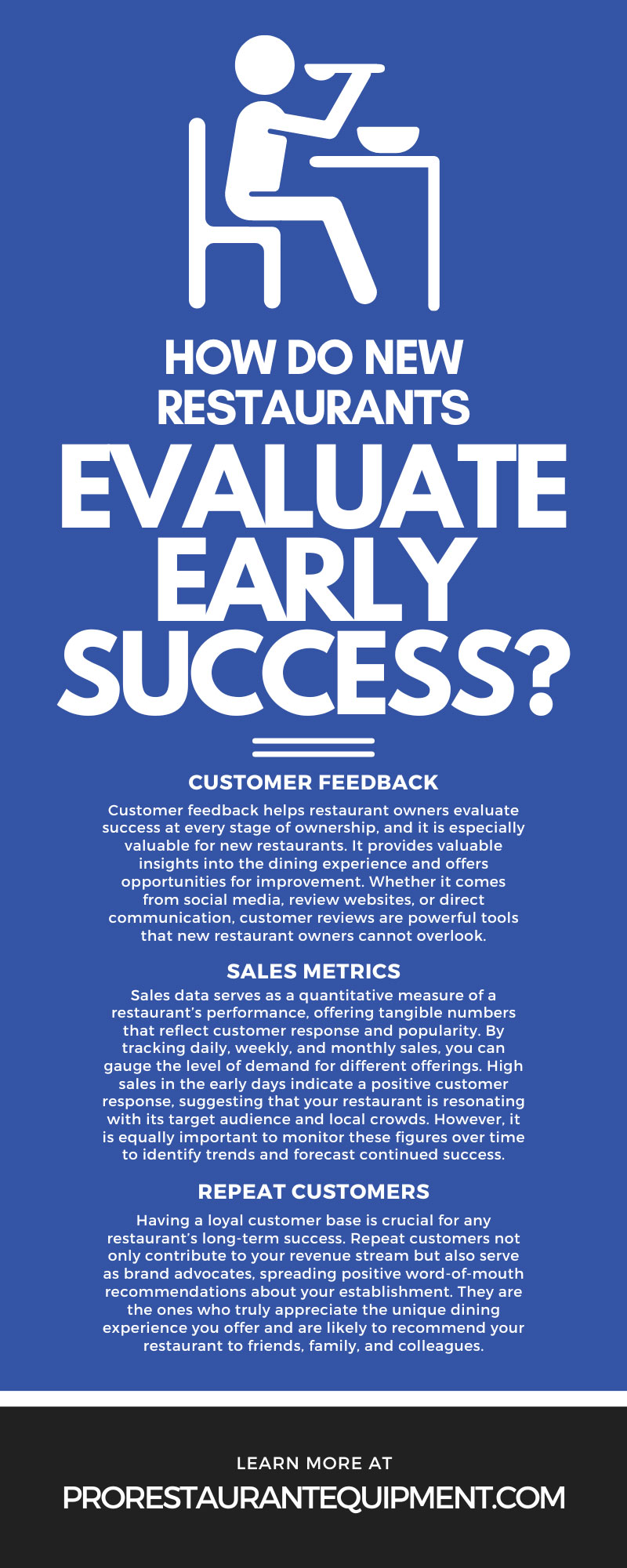Feb 9th 2024
How Do New Restaurants Evaluate Early Success?
Opening a new restaurant is an adventure, and gauging early success is pivotal to ensure your business venture is on the right track. The ways new restaurant owners evaluate early success vary, and each benchmark offers a different perspective on how well the restaurant is performing. The best evaluations combine many metrics, from customer feedback to the frequency of patronage.
Customer Feedback
Customer feedback helps restaurant owners evaluate success at every stage of ownership, and it is especially valuable for new restaurants. It provides valuable insights into the dining experience and offers opportunities for improvement. Whether it comes from social media, review websites, or direct communication, customer reviews are powerful tools that new restaurant owners cannot overlook.
Positive Reviews
Positive reviews serve as clear indicators of success. They signify that customers are satisfied with the food, service, and overall experience at your establishment. These glowing reviews can attract more patrons, generate positive word-of-mouth, and ultimately contribute to the growth of your restaurant!
Negative Reviews
It’s important to recognize that constructive criticism from negative reviews is as valuable as praise. Feedback that highlights areas for improvement can help new restaurant owners refine their offerings and enhance the dining experience. By welcoming and addressing constructive feedback, you can demonstrate your commitment to continuous improvement and customer satisfaction.
Encourage Reviews
You can encourage reviews of your restaurant in many ways. This includes actively engaging with customers on social media, responding promptly to online reviews, and conducting surveys or offering comment cards within the restaurant. By actively seeking feedback, you show your dedication to providing the best possible experience for your patrons.
Sales Metrics
If you’re struggling to receive reviews or want a broader success evaluation, you can look at sales metrics. This data shows big and small-picture success, such as how much money you make over a weekend and how well a specific dish is doing.
Quantitative Data
Sales data serves as a quantitative measure of a restaurant’s performance, offering tangible numbers that reflect customer response and popularity. By tracking daily, weekly, and monthly sales, you can gauge the level of demand for different offerings. High sales in the early days indicate a positive customer response, suggesting that your restaurant is resonating with its target audience and local crowds. However, it is equally important to monitor these figures over time to identify trends and forecast continued success.
Customer Preferences
Sales metrics also provide valuable insights into customer preferences. By understanding what customers are gravitating towards, you can tailor offerings to better meet their needs and expectations. Tailoring your menu to customer preferences will allow you to transform your early success into long-term prosperity!
Future Success
Analyzing sales metrics over time enables you to forecast future success. By identifying trends, such as seasonal fluctuations or changes in customer behavior, you can make data-driven decisions to optimize your operations.
Repeat Customers
Having a loyal customer base is crucial for any restaurant’s long-term success. Repeat customers not only contribute to your revenue stream but also serve as brand advocates, spreading positive word-of-mouth recommendations about your establishment. They are the ones who truly appreciate the unique dining experience you offer and are likely to recommend your restaurant to friends, family, and colleagues.
Loyalty Program
To measure the number of repeat customers visiting your restaurant, you can implement a tracking and monitoring system. One popular approach is to establish a loyalty program. By offering incentives and rewards to repeat customers, you encourage them to return. Then, you can gather valuable data about their preferences. You can also use this information to personalize future dining experiences, such as offering a free dessert on their birthday, which strengthens customer loyalty.
Reservation System
Implementing a reservation system makes it convenient for your customers to book a table. It also provides you with an opportunity to acquire their contact information if they consent to you using it for other business purposes.
With this data, you can inform them about special promotions, seasonal menus, or upcoming events. By staying connected with your customers, you can nurture your relationship and increase the likelihood of them becoming repeat patrons.
Operating at Capacity
Operating at or near capacity is a significant success indicator. When your establishment is bustling, especially during peak dining hours, it’s a positive sign that there is high demand for your offerings. The sight of consistently full tables is a strong testament to the appeal and popularity of your restaurant among customers.
Managing Capacity
Managing capacity efficiently is crucial for continued success. By doing so, you can cater to the demands of your patrons without turning anyone away. Here’s another great advantage of implementing a reservation system: You can streamline the dining experience for your customers, allowing them to secure a table in advance and avoid potential disappointment. Additionally, offering discounts or special promotions during slower hours can attract customers and optimize your seating capacity throughout the day.
As a new restaurant owner, you should keep a close eye on your capacity utilization. Pay attention to the ebb and flow of customer traffic, especially during peak hours, to ensure you and your team are making the most of your dining space. Analyze the trends in customer demands, and consider adjusting your staffing levels and inventory accordingly to meet the needs of your growing patronage.
Operating at or near capacity is not just a measure of success but also a reflection of the trust and loyalty your customers have placed in your establishment. Treat each guest as a valued patron, providing them with exceptional service and a memorable dining experience. By doing so, you will maintain your current success and build a strong foundation for future growth.
These four key metrics exemplify how new restaurant owners evaluate early success. While you may not use all of them, you can get a more detailed and quantitative understanding of your restaurant with at least two.
As you measure your success, you’ll need high-quality equipment to meet demands. Pro Restaurant Equipment offers professional dough mixers and other equipment that will help you successfully cook up your customers’ favorite dishes.


